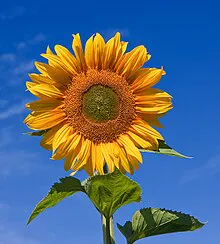
Helianthus
Temporal range: Eocene-recent[1] (Opens in a new window)
 Common sunflower (Opens in a new window)Scientific classification (Opens in a new window)
Common sunflower (Opens in a new window)Scientific classification (Opens in a new window)![]() Kingdom:Plantae (Opens in a new window)Clade:Tracheophytes (Opens in a new window)Clade:Angiosperms (Opens in a new window)Clade:Eudicots (Opens in a new window)Clade:Asterids (Opens in a new window)Order:Asterales (Opens in a new window)Family:Asteraceae (Opens in a new window)Subfamily:Asteroideae (Opens in a new window)Supertribe:Helianthodae (Opens in a new window)Tribe:Heliantheae (Opens in a new window)Genus:Helianthus
Kingdom:Plantae (Opens in a new window)Clade:Tracheophytes (Opens in a new window)Clade:Angiosperms (Opens in a new window)Clade:Eudicots (Opens in a new window)Clade:Asterids (Opens in a new window)Order:Asterales (Opens in a new window)Family:Asteraceae (Opens in a new window)Subfamily:Asteroideae (Opens in a new window)Supertribe:Helianthodae (Opens in a new window)Tribe:Heliantheae (Opens in a new window)Genus:Helianthus
L. (Opens in a new window)[2] (Opens in a new window)Synonyms (Opens in a new window)[2] (Opens in a new window)
Harpalium (Cass.) Cass.
Helianthus (/ˌhiːliˈænθəs/ (Opens in a new window))[3] (Opens in a new window) is a genus (Opens in a new window) comprising about 70 species (Opens in a new window) of annual and perennial flowering plants (Opens in a new window) in the daisy family Asteraceae (Opens in a new window).[4] (Opens in a new window)[5] (Opens in a new window) Except for three South American (Opens in a new window) species, the species of Helianthus are native to North America (Opens in a new window) and Central America (Opens in a new window). The common names "sunflower" and "common sunflower" typically refer to the popular annual species Helianthus annuus (Opens in a new window), whose round flower heads in combination with the ligules (Opens in a new window) look like the sun.[6] (Opens in a new window)This and other species, notably Jerusalem artichoke (Opens in a new window) (H. tuberosus), are cultivated in temperate (Opens in a new window) regions and some tropical (Opens in a new window) regions as food crops for humans, cattle, and poultry, and as ornamental plants.[7] (Opens in a new window) The species H. annuus typically grows during the summer and into early fall, with the peak growth season being mid-summer.[8] (Opens in a new window)
Several perennial (Opens in a new window) Helianthus species are grown in gardens, but have a tendency to spread rapidly and can become aggressive. The whorled sunflower, Helianthus verticillatus, was listed as an endangered (Opens in a new window) species in 2014 when the U.S. Fish and Wildlife Service (Opens in a new window) issued a final rule protecting it under the Endangered Species Act (Opens in a new window). The primary threats are industrial forestry (Opens in a new window) and pine (Opens in a new window) plantations in Alabama, Georgia, and Tennessee. They grow to 1.8 m (6 ft) and are primarily found in woodlands, adjacent to creeks and moist, prairie-like areas.[9] (Opens in a new window)